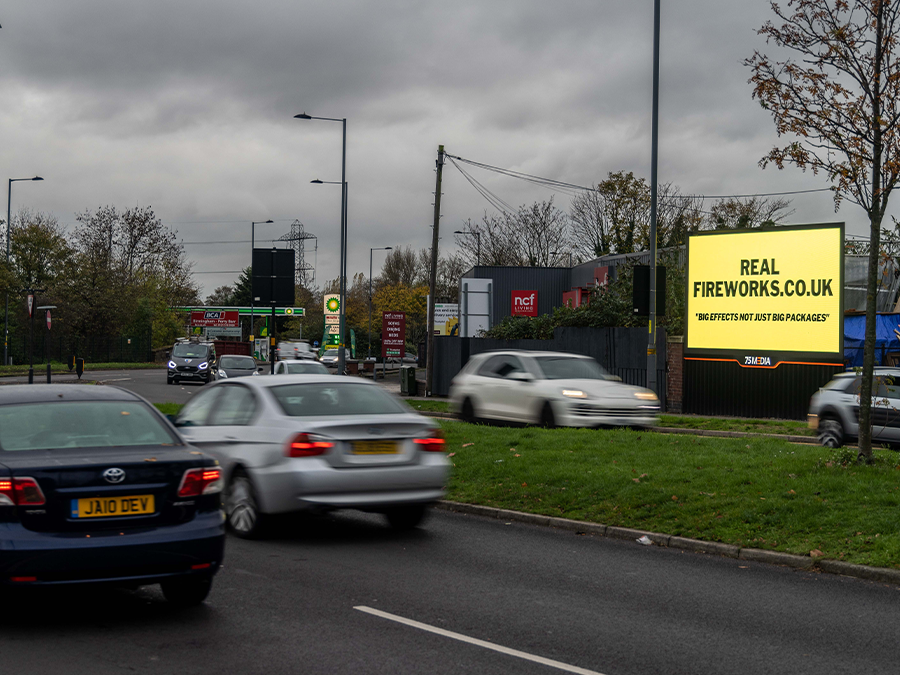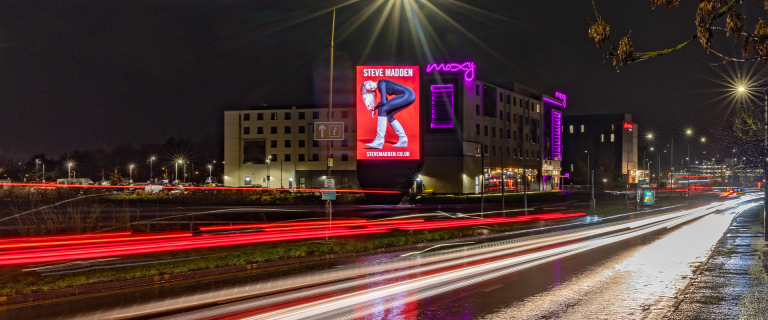While geotargeting is not an uncommon practice in UK marketing (some 95% of global companies already leverage located-based data as part of their marketing strategy), this practice is often misunderstood and underestimated in terms of what it can achieve.
In fact, geotargeting can play a huge role in the integrated marketing campaigns of today, while remaining a fundamental driver of out-of-home (OOH) advertising.
In this post, we’ll explore geotargeting in further detail, while asking how this work and its main benefits from the perspective of OOH advertisers.
A Closer Look At Geotargeting
In simple terms, geotargeting describes a method of delivering various types of content that have been personalised to suit a particular customer’s location.
Through the practice of geotargeting, you can communicate effectively with customers based on their precise geographical location, through a variety of means such as online ads, invitations to local, in-person events and the marketing of exclusive in-store promotions.
In the digital age, one of the most common ways of leveraging geotargeting is through IP addresses.
IP address describe a unique string of characters that identify each computer device as it uses the Internet Protocol to communicate over a private or public network.
The first three digits of an IP address relay the country code, while the following parts of the code combine to provide more granular location data such as state, city and post code.
There are numerous online advertising mediums that leverage geotargeting and IP addresses, with Google Ads offering one of the best-known examples.
This platform enables users to establish a location variable or create a geographical radius in which targeted ads are displayed, usually pertaining to physical store locations.
Similarly, you can pinpoint a customer’s location through device ID and WiFi, while advanced GPS signals can also be used to determine a person’s whereabouts and movements.
How Does Geotargeting Work?
The question that remains, of course, is how exactly does geotargeting work?
Well, it broadly works by detecting users’ locations, through specific tools such as GPS or on a much broader scale through the deployment of cell towers.
From here, bespoke geotargeting software or apps collate and analyse this information, before deciding which data or messaging to present to target customers.
The most common iteration of this technology is embodied by geotargeting apps.
This refers to any type of software-driven app that utilises location-based marketing, including widely used examples like Deliveroo or Just Eat.
Whenever you create an account on this type of app, you’ll enter a postcode that refers to your real-time location.
This will automatically tailor listings to highlight the results that are closer to your location, creating an improved consumer experience and generating viable leads for brands as a result.
Google also utilises geotargeting software as part of its search engine page results.
So, when you search for a particular service provider in your area (by entering something like ‘mechanics near me’ in your Google Maps application), the results will be organised based on your real-time location.
When it comes to the intuitive use of garnered data, geotargeting software operates in a way that enables you to better reach your target audience.
It achieves this primarily by allowing advertising to access different datasets and types of targeting tools.
We’ve outlined three examples below, while asking how they help brands to leverage geotargeting to their advantage:
Audience Targeting
With audience targeting, you look to target identify key demographics based on core behaviours.
For example, you could create targeted online ads to reach people who have visited a specific brand, category or location within a fixed period of time, or establish detailed customer portfolios based on observed shopping behaviours.
The key here is to better understand customer behaviour and drive data-driven marketing decisions over time.
Location Targeting
Location targeting is synonymous with location targeting, which affords further insight into how consumers behave and move in specific regions.
One example of this is the use of on-site mobile location targeting, which provides real-time insight into your customers’ whereabout and enables you to tailor your messaging based on this insight.
You can also observe collective behaviours in neighbourhoods to help build and develop viable promotions.
Weather Targeting
This is a fascinating geotargeting development, and one that allows marketers to adapt and match their messaging to suit the real-time conditions.
This is particularly effective in the field of out-of-home (OOH) advertising, where the content featured on interactive displays can be amended according to shifts in weather and optimise messaging to drive increased rates of brand interaction.
Similarly, OOH messaging can be displayed at specific times of the day, in order to optimise impressions and target customers when they’re most likely to engage with the brand.
Geotargeting in OOH Advertising – The Key Considerations
This brings us neatly on the relationship that exists between geotargeting and OOH advertising, with the former having played a key role in popularising ad channels such as billboards in the digital age.
To understand this in more detail, let’s take a look back at British Airways’ monumental ‘Look Up’ campaign.
This captured the imagination of customers by creating an interactive ad that became animated when planes flew overhead.
More specifically, the billboard would show a child on the display, who would rise up and point to the sky as a specific plane flew overhead.
This creative ad was based on the principles of geotargeting and GPS, as moving planes were tracked in real-time and identified through in-built surveillance which then activated the billboard’s animation.
This highlights how geotargeting can be used to activate, animate or adjust billboard content in real-time, in order to capitalise on optimised levels of footfall or utilise the surrounding conditions and environment to an advertiser’s advantage.
One of the key technologies in this respect is ‘geofencing’, which leverages both GPS and radio frequency identification (RFID) to redefine geographical boundaries.
To achieve this aim, it may also use IP technology, with a view to establishing a virtual boundary around a strategically targeted geographical location.
Underlying software or connected apps then trigger predetermined actions whenever a mobile device (or RFID) tag enters the location, from SMS and social media messages to data tracking.
In practical terms, let’s say that you own a physical retail store and want to run an exclusive, limited-time promotional offer.
Through geofencing, you can target viable audiences as they move within a predetermined area, deploying real-time messaging and coupons to a mobile device as a way of generating qualified leads.
This not only creates a sense of urgency in target customers, but it may also discourage them from shopping with competing brands as they consider your exclusive offer instead.
What are the Benefits of Geotargeting in OOH Advertising?
Ok, we hear you ask, but what are the primary benefits of geotargeting for OOH advertisers?
We’ve outlined three of the most important below:
Create More Personalised and Engaging Content
There’s no doubt that personalisation is a key driver of marketing campaigns in the digital age, which is just of the reasons why geotargeting is so popular across the board.
According to studies, some 72% of consumers say that they now only engage with marketing messages that have been tailored to their interests, while other examples of personalisation relating to their behaviours, culture and expectations are also increasingly welcome.
It’s also fair to surmise that an individual’s location may also offer insight into aspects of their mindset and purchasing power, offering further opportunities to brands who want to optimise product offerings in relation to different audiences.
When dealing with OOH specifically, advertisers are often required to command the attention of passing traffic in just a few seconds.
So, despite the innately engaging nature of OOH and its ability to appear non-intrusive and blend seamlessly into the surrounding environment, it’s crucial that audiences can connect with your messaging and identify emotive hooks in a few seconds.
By delivering messaging that’s personalised and has been augmented to suit changeable weather conditions and a constantly shifting environment, you can certainly create more relevant content that appeals to customers on a far more immersive level.
Increase the Click Through Rate (CTR) of Your Campaigns
With most OOH campaigns, you’ll probably erect a number of ads in different target locations as a way of optimising your reach and interacting with as many demographics as possible.
Similarly, you may want to target certain customer demographics at predetermined times of the day or week.
For example, you may want to advertise a fast-food brand to local commuters during the evening rush hour, in order to optimise conversions and the return on your marketing spend.
With these points in mind, integrating mobile technologies with geotargeting software can prove highly generative.
More specifically, they’ll increase the coverage of your messaging within target locations, by creating multiple touchpoints through which customers can engage with the brand and content of the ad.
This also translates into increased brand awareness and recognition, which can contribute to the success of further OOH or integrated campaigns in the future.
Interestingly, creating accessible touchpoints in close proximity to OOH ads is thought to drive a significant increase in click through rates (CTRs), with one particular case study revealing a 50% hike in this metric over the course of a campaign.
This is a huge advantage of brands and OOH advertisers, so it’s definitely something to keep in mind when established the granular detail of campaigns and looking to leverage geotargeting successfully.
Define Your Audiences with Greater Accuracy
Historically, OOH advertisers have been restricted in terms of accessing detailed consumer data, even in strategically targeted locations that offer access to increased footfall.
This can create even more significant issues when looking to target audiences at specific times of the day, as you’ll need to develop an understanding of customer profiles and their behaviour in order to build cost-effective and engaging campaigns.
However, geotargeting can help in this respect, especially when you use this to leverage the increased technological capacity of smartphones and the immense datasets collated by mobile devices.
For example, you can use mobile technology and in-built GPS software to identify the location of customers within specific timeframes, while accessing data of their movements and how they’re likely to interact with your content (including the direction through which most consumers approach it).
This can build incredibly detailed and granular datasets which offer an insight into the efficacy of individual ads of campaign, particularly in terms of measuring the number of ad impressions generated and associated conversion rate.
What’s more, more recent advancements have seen the data gathered from millions of smartphones combined with the tracking of connected vehicles and increasingly broad GPS systems.
This enables more accurate detailed tracking and the delivery of increasingly telling insights, while it may also lead to better measurement of OOH campaigns and more informed decisions over time!
The Last Word – Where Can I Find OOH Advertising That Leverages Geotargeting?
While the notion of geotargeting in marketing is nothing new, this technology has continued to evolve over time (both in terms of the data that it can harness and how it delivers messaging to target customers in real-time).
As brands have also evolved to understand the immense appeal of geotargeting in the age of big data and integrated marketing campaigns, agencies have also been quick to make this a part of the services that they provide.
This includes OOH agencies such as 75Media, for whom geotargeting has become a key component of delivering effective and generative campaigns.
To make the most of geotargeting, the key is to have a clear understanding of your marketing and campaign goals, while addressing precisely how these can be better achieved through techniques like geofencing.
From here, you can work with service providers and different channels to determine a clearly defined strategy, and one that ideally combines geotargeting with both on and offline marketing channels.
This can really deliver benefits for your brand and customers, creating a win-win scenario that adds value across the board!







